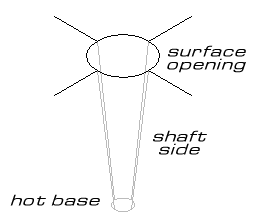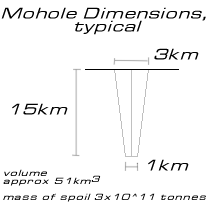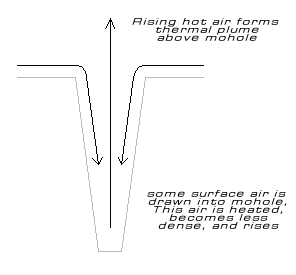

|
MOHOLES: AN OVERVIEW |
|
|
The actual structure of a Mohole is extremely simple, its name partly conveys its whole meaning, Moholes are just very big, deep holes. Moholes transfer heat from deep underground, into the air inside its great bore, this hot air plumes up through the Mohole and up into the atmosphere. In this way Moholes can heat the atmosphere and this heated atmosphere can heat the land, cold surface air is drawn down into the shaft by density, and to equalize the pressure by the air in the thermal plume leaving the Mohole. |
 |
 |
The construction of a Mohole is not too difficult, but the amount of material that has to be moved will make construction processes with conventional technology slow, the progress speed is proportional to the amount of material needed to be removed, a large deep Mohole should take longer to construct than a small shallow one. |
|
The technology available will dictate how the Mohole is built, in the middle 21st century when the first Moholes were being sunk on Mars, automated robotic vehicles and machinery were used, in subsequent centuries shield and wormhole technologies were used to excise the ‘core’ of the Mohole. |
 |
|
The spoil material removed from the shaft can be fed into other machinery for processing, on early Mars this material was used for a great number of things, for the production of atmospheric gases, construction material, and production of more vehicles and robots to work on projects. Moholes become the foci for town development, they offer good sites for construction and manufacture, also using heat recovery methods energy can be retrieved from the Moholes to power the early settlements. |
|
|
Moholes are really large construction projects, they are kilometers wide, and many kilometers deep, on mars typically between 10-20km, they are tapered towards there bottom, this allows winding spiral roads to be formed on the walls, which would greatly simplify removal of spoil. Sinking high temperature super-conducting cables can increase efficiency of a Mohole, these cables transfer heat from even further down, this method is used to supplement heat output from existing Moholes, the cable sinking technology itself is useful for generating geothermal power. |
|
|
Martian Moholes in the Northern hemisphere were eventually inundated by the Oceanus borealis, this flooded Moholes helped to keep the sea liquid, and acted to drive currents through the early sea, the warm water plumes provided ideal nursery sites for new introduced marine species. |
|
|
Moholes provide a practical method for heating an atmosphere, and also aid a developing hydrosphere, also the thermal plumes could be used to transport material high into the atmosphere, especially fluorocarbons and engineered dust. |
|










